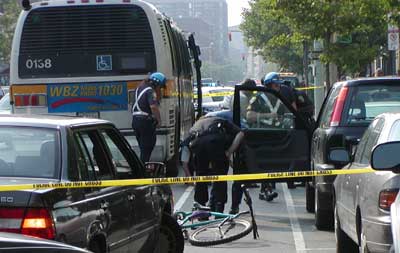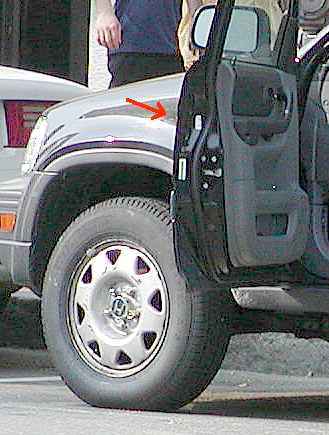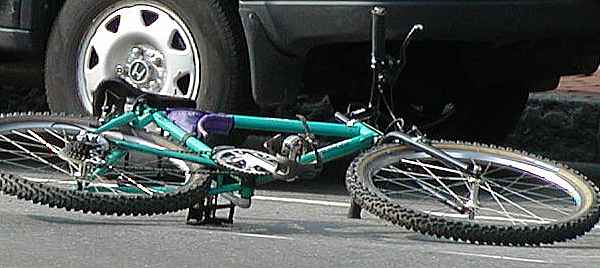 Robert Winters, Cambridge Civic
Journal |
Top: Home Page
Up: Table of contents
About the Dana Laird fatalityJohn S. Allen, July 25, 2002 Note: I work as an expert consultant and expert witness, but I will decline to work in any case which follows from the Dana Laird crash, for two reasons: 1) I would have a conflict of interest, as a former member of the Cambridge Bicycle Committee; 2) I consider it important to make my position a matter of public record now. I can not accept being restricted by confidentiality requirements. |
 Robert Winters, Cambridge Civic
Journal |
What happened?At approximately 3:45 PM on Tuesday, July 2, 2002, cyclist Dana Laird was killed in front of 501 Massachusetts Avenue, Cambridge, Massachusetts, USA. Ms. Laird was 36 years old and a doctoral student at the Fletcher School of International Law and Diplomacy at Tufts University, in Medford, Massachusetts. At the time of the crash, she was headed home to meet a friend. She had planned to attend a Boston Red Sox baseball game later in the day with members of a women's chorus in which she sang. A motorist opened the door of a parked sports utility vehicle across the bike lane in which Ms. Laird was traveling. Ms. Laird swerved and lost control. According to eyewitness accounts, she yelled, "flew through the air" and apparently struck the door. She went under the right rear wheels of a passing transit bus, and she was killed instantly. Swerving or braking might possibly have led to a loss of control before Ms. Laird reached the door. Robert Winters's photos show the bicycle lying well behind the door, suggesting that Ms. Laird may have separated from it before reaching the door. However, the bicycle may not lie where it came to rest after the crash. Also, it is notoriously difficult to predict which way the bicycle will go after separating from the cyclist. Police at the scene reported marks on the SUV's door, and a photo (below) shows what appears to be a mark at approximately handlebar height. Rotation of the handlebars from a collision with the door would have caused the bicycle to fall to the left. An eyewitness reported that the collision swung the door open wider. The door's swinging open would have propelled Ms. Laird to the left. The police report should allow more definitive conclusions. |
 Robert Winters, Cambridge Civic Journal |
This crash might be examined from several perspectives -- those of the traffic law, crash prevention, safety research, and tort liability -- and well as a larger perspective which encompasses moral issues and urban planning issues. I will examine the crash from these perspectives, to the degree I can. The traffic lawAccording to news reports, the motorist was cited with violations for opening the door carelessly, and for driving an unregistered vehicle. Cambridge has an ordinance prohibiting motorists from opening their car doors carelessly, though the Commonwealth of Massachusetts has none. The vehicle was parked several inches from the curb but within legal limits. Ms. Laird was operating her bicycle in compliance with the traffic law. The bus driver was operating in compliance with the traffic law, did not have time to stop or swerve, and was not cited. Crash preventionHow could this tragedy have been prevented and how could similar ones be prevented in the future?
|
 Robert Winters, Cambridge Civic
Journal |
Safety researchDooring crashes are a much higher percentage of car-bike collisions in the Boston area than in the nation as a whole, as shown in the 1984 Metropolitan Area Planning Commission study. The rate recorded is 5.3%. The study attributes this result to the large amount of parallel parking in the Boston area, and to congested conditions. Probably no bike lanes existed in the Boston area when the MAPC study was conducted. The first ones of which this author is aware were installed in Lexington around 1990. The MAPC study concerns all cities and towns within the Route 128 peripheral highway. These are a mixture of very urban, suburban and semi-rural. It is very likely that dooring crashes accounted for 10% or more of the total in urban Cambridge. Other studies give similar rates for cities with on-street parking, and one study for Santa Barbara, California, a city with high bike lane mileage, shows the highest rate of all, 16%. An earlier study including the same city shows a much lower percentage, though the comparison is not perfect. (See page summarizing research into dooring collisions). Dooring collisions can occur with or without bike lanes, but placing a bike lane in the door zone encourages cyclists to risk such collisions, in two ways: by encouraging bicyclists to ride on the streets with bike lanes, and by promoting a false sense of security about riding in the "door zone". Crashes involving a motorist entering from a cross street or driveway, or a pedestrian, are more likely when the cyclist is concealed by parked or waiting motor vehicles. Bike lanes in the "door zone" place bicyclists in this position. The combined risk of these crashes is much greater than that of overtaking collisions, fear of which is a common reason for riding in the "door zone." Crashes involving motorist turns are more likely when a cyclist overtakes a waiting motorist on the right, a behavior encouraged by bike lanes. At least 4 fatalities in such crashes have occurred in the Boston area in the period 1999-2002. Tort liabilityWho might be held at fault for this crash under the law? The motoristCertainly, the motorist could be found negligent, as attorney Andrew Fischer has indicated in postings on the massbike e-mail list. The cityThe City might be held negligent for creating what is called in legal language an "attractive nuisance" -- that is, a baited trap. Ample evidence exists that the City of Cambridge had been notified of the hazards of bike lanes in the "door zone" before the Massachusetts Avenue lane was striped, yet the City continued to stripe them. The City might defend this practice by arguing that all in all, the bike lane is safer than alternatives. Research does not support such a claim, and many alternatives exist -- including the alternative of doing nothing at all. If it were argued that no alternatives exist, then the question would still arise as to whether the City should create a trap for the unwary. A facility is less likely to be consided defective if it meets recognized guidelines for bicycle facilties. Does the bike lane met AASHTO (American Association of State Highway and Transportation Officials guidelines)? Let's look at the most recent editions of two AASHTO guides. The AASHTO Guide for the Development of Bicycle Facilities [1999 edition, page 22] says:
The new AASHTO Green Book (A Policy on Geometric Design of Highways and Streets, 2001, 4th edition). says:
The bike lane at the location of the crash began 7 feet 5 inches from the curb and was 5 feet wide. It was almost entirely within the "door zone". The width from the curb to the left side of the bike lane does exceed by 5 inches what the Guide for the Development of Bicycle Facilities requires -- but Central Square is an area with high parking volume and turnover and so more width would be "desirable." Also note that the Guide considers the right bike lane stripe to be optional. The right stripe is the one that conveys the impression that it should be equally safe to ride anywhere in the bike lane. In fact, only the very left edge of the bike lane provides adequate spacing from an opened car door. Geometric Design of Highways and Streets allows an even more inadequate spacing when there is no bike lane. The wording "maneuver around an open door" is odd. If the door opens suddenly, the cyclist would have to swerve, possibly into the path of an overtaking vehicle. Riding predictably outside the range of any door that might open is safer than taking this risk. The bike lane does conform to AASHTO standards, though it lacks "desirable" width for high parking turnover. The idea that "desirable" width increases with more parking is odd, because car doors are just as wide when parking turnover is low. The bus driverThe bus driver and the Massachusetts Bay Transportation Authority could not reasonably be found negligent. The bus driver was operating in compliance with the law, and had no opportunity to prevent injury to Ms. Laird. The installation of shields along the sides of buses is not a standard safety measure in this country and might not be practical on a bus like the one involved in the crash. The only part of the side of the bus that is open is the wheel well, and if Ms. Laird had struck the wheel itself, it is very unlikely that she would have gone under it. Ms. LairdMs. Laird might be found negligent if she was aware that she was increasing her risk by riding too fast in the "door zone", but rode there anyway. This conclusion is not very credible. The fact that Ms. Laird was riding faster than is safe testifies to her evaluation of the risk. The bicycle manufacturer and retailerThe bicycle manufacturer and retailer could not reasonably be charged with negligence for the long handlebars. It is not clear that Ms. Laird's loss of control was precipitated by a handlebar strike. Neither is it clear whether shorter handlebars might have prevented one, or prevented the crash. Long handlebars are preferable for some types of riding; the manufacturer and retailer had no control over where Ms. Laird chose to ride. For similar reasons, the manufacturer and retailer can not reasonably be charged with negligence for the knobby tires. Ethics: social engineering vs. personal safetyTaking on larger ethical issues is difficult, but I will try. A central issue is that the City maintains that the social good of encouraging bicycle use justifies the striping of bike lanes. I agree that increased bicycle use is a social good. Cycling is a desirable transportation mode. Cycling provides good mobility at low cost. Cycling has benefits in reducing air pollution, demands on parking space, and use of fossil fuels. It provides healthy physical exercise.. But does it follow that the promotion of bicycle use justifies the striping of bike lanes? Only, in my opinion, if they are an appropriate measure considering the conditions, and are well-designed and maintained to avoid creating more problems than they solve. Some bike lanes, including at least one Cambridge installation, provide real improvements -- but the ones on Massachusetts Avenue have serious problems. Massachusetts Avenue is a heavily-traveled arterial street, with parallel parking along most of its length. Illegal parking also is common, and much of it is unavoidable, as truckers must make deliveries to retailers. When not blocked by illegally-parked vehicles, the bike lanes can provide a channel in which bicyclists can overtake on the right side of slow or stopped traffic. However, such overtaking is only safe at very low speeds and where vehicles can not turn across the bike lane. Where vehicles can turn, it is imperative for a bicyclist to merge into the flow of motor traffic to avoid motorists' right rear blindspot, or else to stop. Unless traffic is at a standstill, bicyclists can travel faster, with safety, by staying out of the "door zone." All in all, it is only safe for a cyclist to ride on Massachusetts Avenue by having a realistic understanding of crash risks, and the skills to operate as a vehicle driver in mixed traffic. The bike lanes delude na´ve cyclists into believing that they can be safe without these skills, direct cyclists to ride in a location which is never safe except at slow speeds, and reinforce cyclists' incorrect understanding of the risks they confront. Improved law enforcement and education would increase the safety of cyclists on Massachusetts Avenue. Cambridge is ahead of many other communities in this respect, but it is unlikely that the City, which installed the bike lanes in the door zone, will instruct cyclists not to use them. That task must, then, fall to bicyclists' organizations, to colleges and universities, and to private entrepreneurs. It is not a simple task. I will have more to say about the task of education in the next section of this report. The Massachusetts Avenue bike lanes do not safely allow fast enough travel for the present, young, healthy student bicycling population on their efficient, multi-speed bicycles. The Cambridge city officials appear to think that the bike lanes will entice an entirely new and different demographic group to use bicycles -- people of all ages and walks of life, who will be content to ride more slowly. I have long maintained that facilities that attract the non-student population will start at people's front doors with neighborhood traffic calming, rather than out on the main streets. I began my career as a cyclist by riding on residential streets, and with time I came to use the main streets more. That is how it is with almost every cyclist. And in any case, the travel speed which is safe in the bike lanes is lower than the desired speed of any cyclist. Furthermore, the City's response to the door zone problem has been unrealistic. Sure, motorists should look before opening their doors. But they don't always. I learned to stay out of door zone bike lanes before there were any. Unfortunately, Ms. Laird did not learn this. She was highly educated, but not on the subject that would have saved her life. Encouraging the general population to ride bicycles is not an easy task. Motor vehicles are heavily entrenched in American society, public transportation in Cambridge is quite good, and it's even harder to convince people to ride when the bike lanes fail to prevent incidents such as the death of Ms. Laird. To the degree that the bike lanes delude cyclists into a false sense of security, lead to avoidable crashes, so damage the appeal of bicycling, and turn attention and funding away from more practical, safer and more effective measures, I regard the City of Cambridge as holding considerable moral responsibility for Ms. Laird's death, and for loss of appeal of bicycling. The importance of educationMany if not most cyclists in Cambridge are college and university students, like Ms. Laird, or recent graduates. The colleges and universities have a sterling opportunity to educate their student cyclists -- and to their own benefit. Even if only cold financial issues are considered, avoidable injuries and fatalities to students have an impact on a college or university out of all proportion to the cost of educating student cyclists. The cost to society as a whole of losing young, talented, highly educated persons like Ms. Laird is far higher yet. The educational challenge is not a simple one. Consider that Ms. Laird was not only highly educated but also an accomplished athlete. She ran marathons and had taken a sea kayaking trip in Alaska. But even just from examining photos of her bicycle, it is clear that her bicycling skills did not measure up to those in her other physical activities. The initial bicycle fit and adjustment session in a bicycle driver training class would have addressed not only the long handlebars and off-road tires of her bicycle -- but also:
These issues are all too typical with Cambridge cyclists. The class also would have covered all the road safety issues discussed earlier. Real bicycle driver training is necessary to overcome the problems that arise from low levels of skill. A publicity campaign aimed at one or another isolated issue will not do the job. To explore these issues in more depthInformation on riding on the road is available, for example, in the pamphlet Bicycling Street Smarts, available online and in print; in the book Effective Cycling, by John Forester, and on the Web sites of the North Carolina Coalition for Bicycle Driving, Ken Kifer and others. Bicycle driver training is available in Massachusetts through the Massachusetts Bicycle Coalition, and nationwide through the Bike-Ed program of the League of American Bicyclists. Other choices might be made in street design. A page which has already been posted has made recommendations about Massachusetts Avenue. See the last paragraph. Also see the other pages about the Cambridge bicycle program and bicycle facilities. These include a page about a Cambridge bike lane installation which does not have dooring problems. *** Thanks to Robert Winters, Paul Schimek, Michael Halle, Kathy Murphy (Cambridge Police bicycle patrol), Bill Clarke, John Ciccarelli and Alan Wachtel for their valuable contributions. Thanks also to several others who have suggested corrections and clarifications. Additional comments are welcome. |